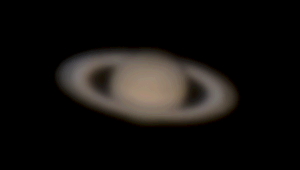
Planets, Omega Centauri, Ring Nebula, Galaxies,
Comet PanSTARRS; iPhone 5s: Saturn
Posted: 15 June 2014
Cloudy and windy nights, and night work at Oracle State Park in support of the "International Dark Sky Park" proposal have kept me from my observatory. On Thursday, 12 June 2014, just before I left home to go to the Park, a small wildfire (4 acres) broke out near the Park. Thanks to the rapid and effective response of Oracle Fire Department and nearby agencies, the fire was quickly brought under control, although one home and some smaller buildings were destroyed. The skies cleared and the strong winds ended after sunset on Saturday, 14 June, and I opened the observatory.
|
Opened: Saturday, 14 June 2014, 1959 MST Temperature: 88°F |
Session: 695 Conditions: Mostly clear, calm |
2005 MST: viewed Jupiter, low in the western sky, 83X. The four Galilean Moons were visible. Seeing was bad. As I was writing up the observation in my logbook, a Kissing Bug landed on the logbook next to my hand. Terminated!
2010 MST: viewed Mars, 83X. No details visible. Switched to 222X; seeing not very good but could see North Polar Cap and some dark areas. Seeing not good enough for imaging.
2014 MST: viewed Saturn, 222X. Seeing was not great but Cassini Division and 3 moons were visible (Titan, Rhea, and Tethys). 2019 MST: the moon DIone was now visible. Using 83X, tried to see the moon Enceladus, but it was too close to the bright ring system.
2030 MST: observed Omega Centauri (globular cluster), 83X. The view was hampered by the twilight sky.
Decided to redo the AutoStar star alignment, which hadn't been done in a long time. It took a longer than expected as I had to clear out the "Two Star bug" after inadvertently selected "Two Star" align instead of "One Star". Clearing the bad data out requires changing the mount setting to "Alt/Az" (in the AutoStar only; no need to change the actual mount), doing an "Easy Align", changing the mount setting back to "Polar", and then doing a "One Star" align. Before clearing the bad data, a "One Star" align resulted in bad GOTOs. Once the bad data was cleared and the second "One Star" alignment was done, GOTOs were excellent. Completed the process at 2100 MST.
Viewed M57 (Ring Nebula; planetary nebula), 83X. Then returned to Omega Centauri; better view now with Astronomical Twilight almost at an end. But the rising waning gibbous moon was brightening the sky. Viewed some galaxies using 83X: M104 (Sombrero Galaxy) and M65/M66/NGC3628 (Leo Galaxy Triplet).
Went back to Mars and observed it using 83X and 222X. Seeing was a little better but still not good enough for imaging.
Then went to Saturn. At 222X, seeing was pretty good. Began setting up for iPhone 5s afocal imaging. Before I attached the iPhone to the telescope, I received an email from a fellow observer. He reminded me of Comet PanSTARRS C/2012 K1. (Thanks Richard!) I decided to check out the comet. I got its current RA/Dec using SkySafari Pro on my iPhone 5s and manually entered the position into the AutoStar. There were some clouds in the sky near the comet and the sky was getting brighter from the rising moon, but at 2126 MST, the view of the comet was nice using 83X. The coma (somewhat faint) was easily seen. A short stubby tail was just visible using averted vision. Will image (hopefully) on the next session.
2130 MST: Back to Saturn to image it. Noticed three Kissing Bugs in the observatory; all terminated. A cloud was now approaching Saturn. Did several 1, 2, and 3 second slo-mo (120 fps) video recordings at 666X, changing the position of Saturn in the field-of-view between each set. Here are two images, the left image is a stack of 297 frames (a little over 2 seconds) and the right image is a stack of 125 frames (1 second):


2147 MST: last look at Saturn, 83X. Sky was bright due to the rising waning gibbous moon (still behind the hill to the east).
|
Closed: Saturday, 14 June 2014, 2157 MST Temperature: 76°F |
|
Comments are welcome using Email. If you are on Twitter you can use the button below to tweet this report to your followers. Thanks.
Cassiopeia Observatory Home Page